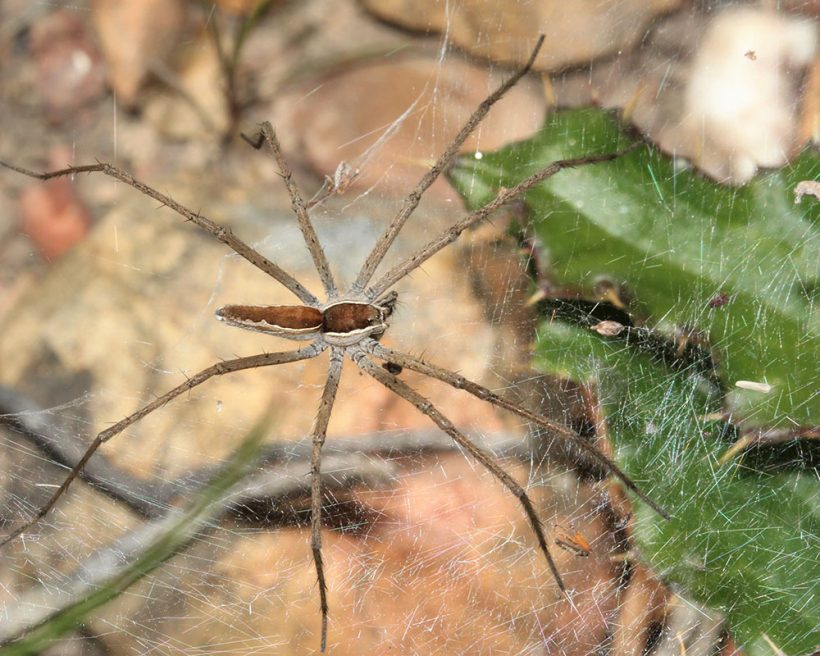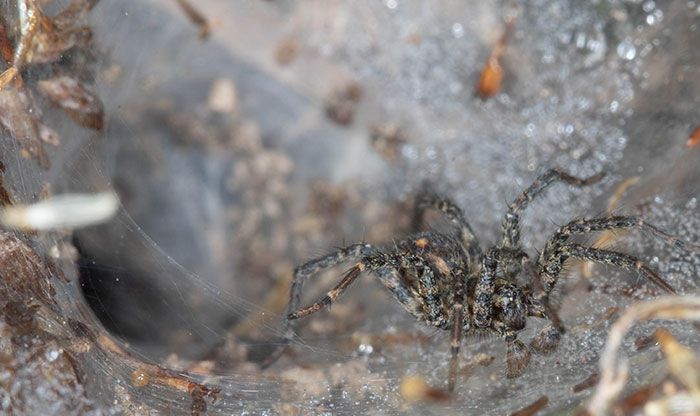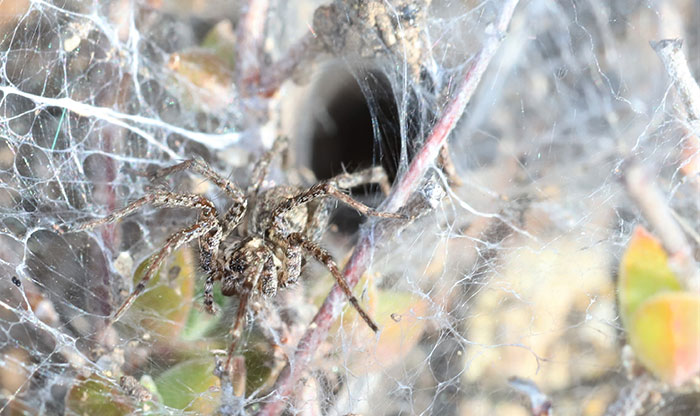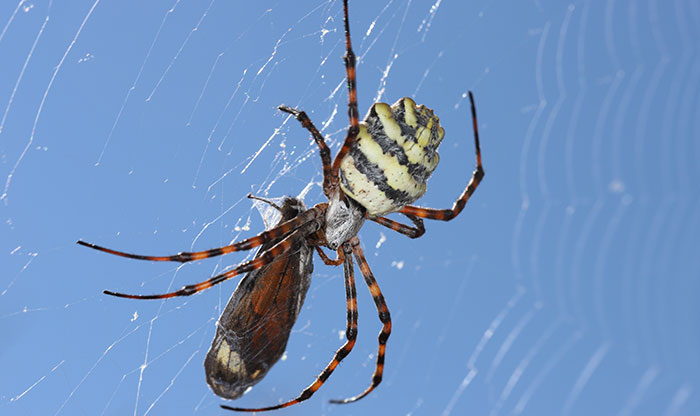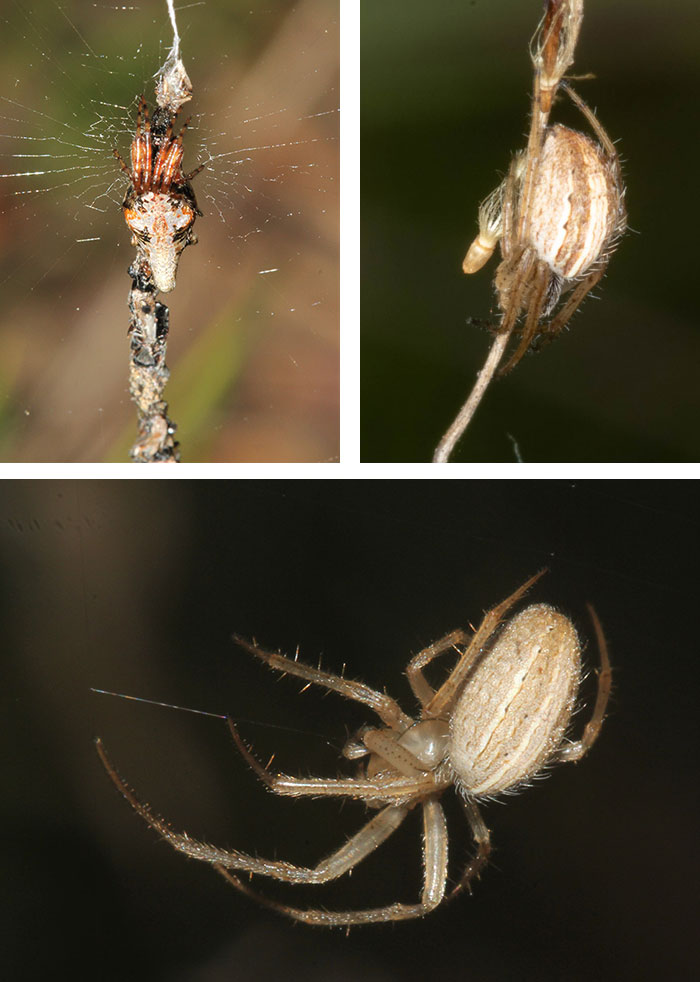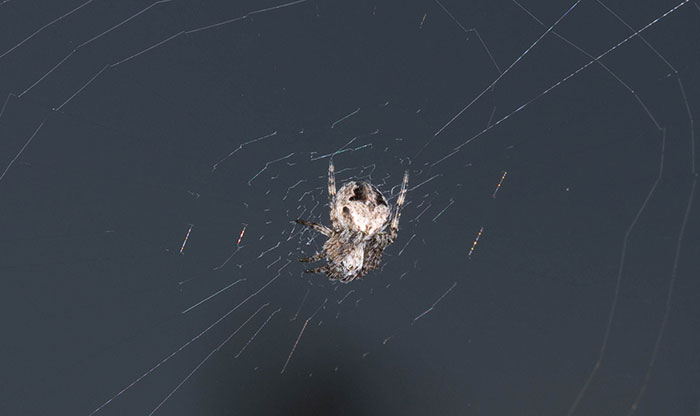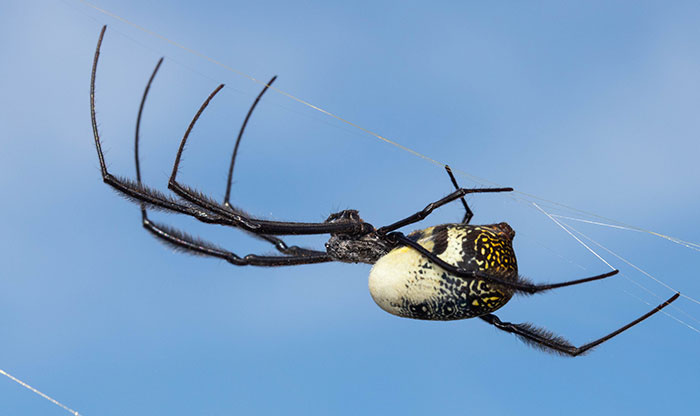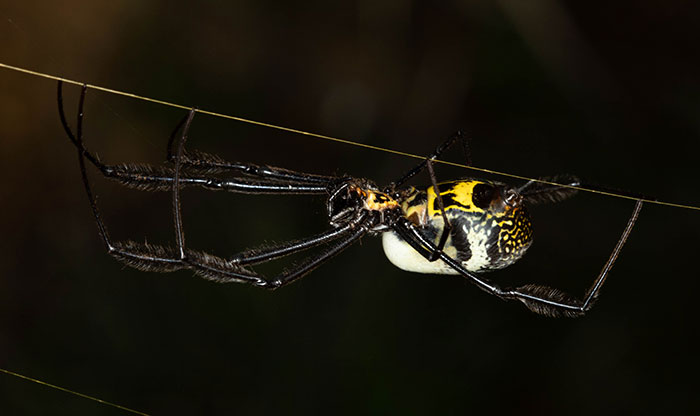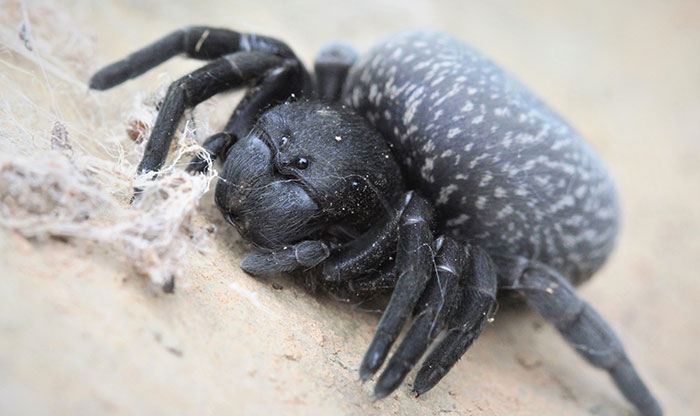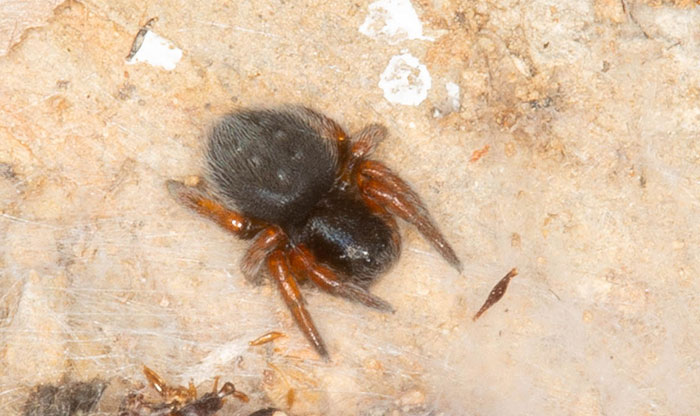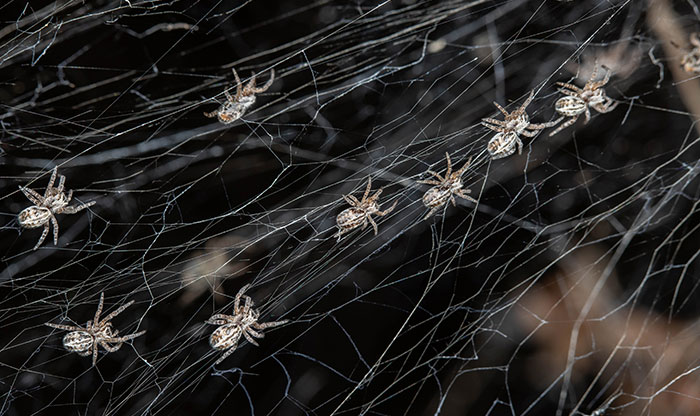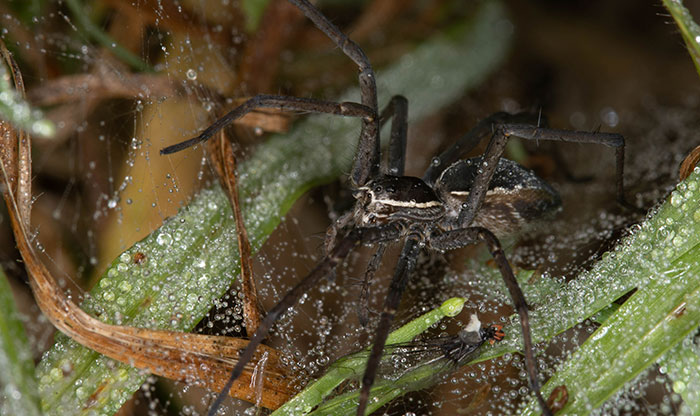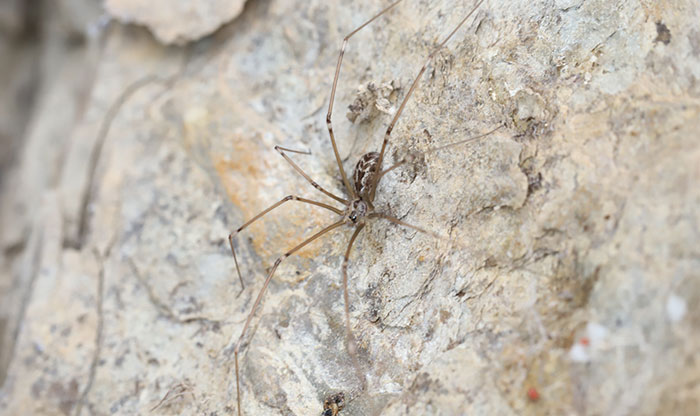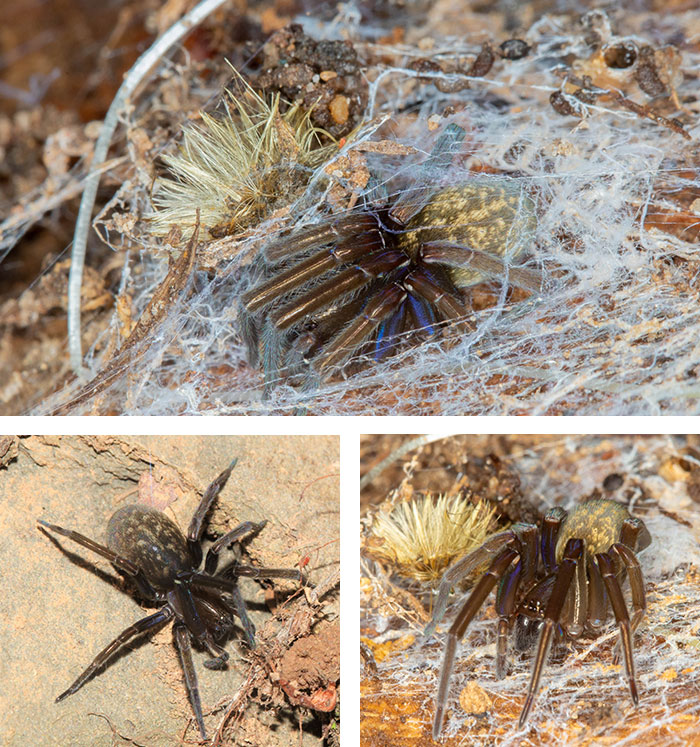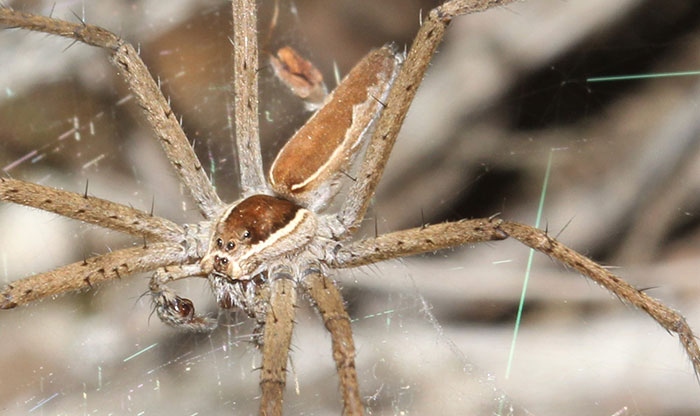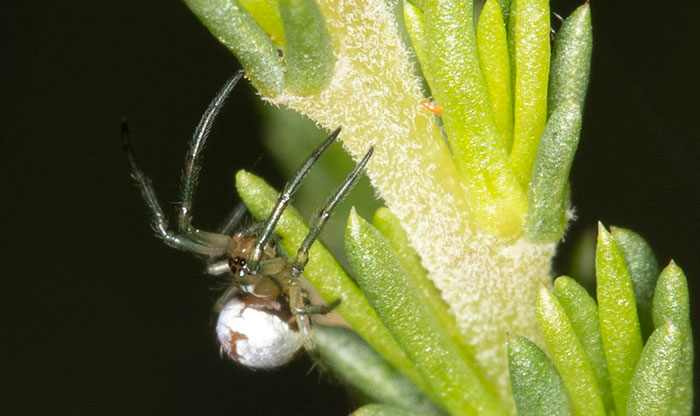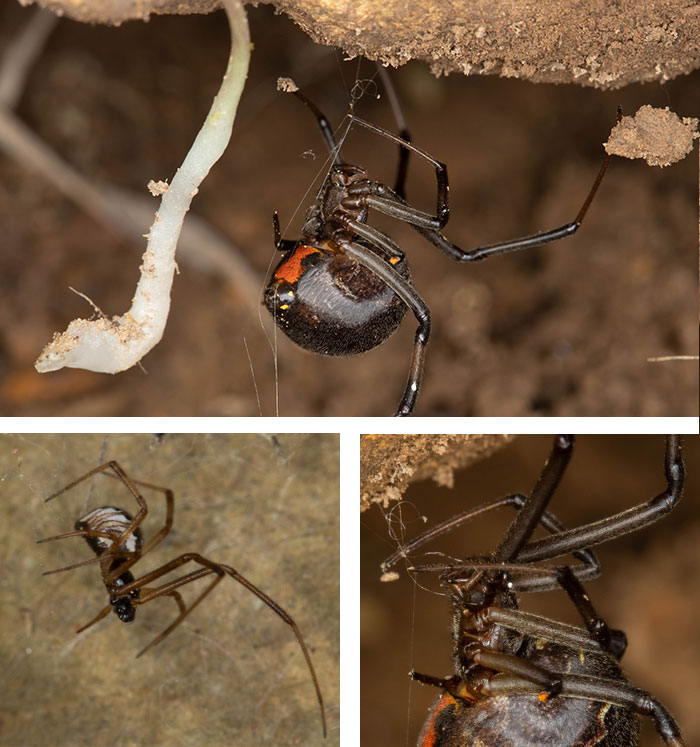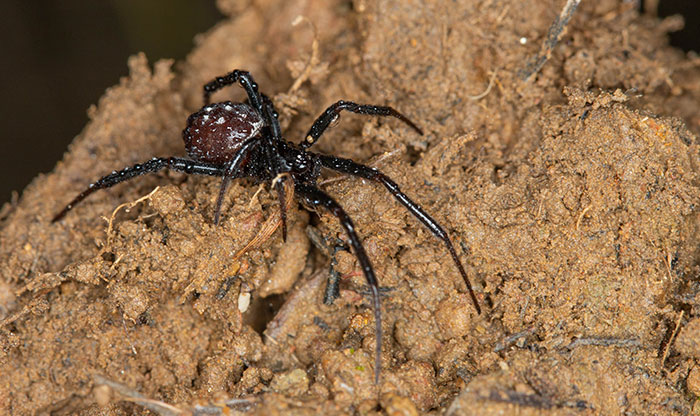Above: Nursery or Sheet Web Spider, Pisauridae family.
Meet some of the wonderful critters you’ll find in Renosterveld – in particular, the web-dwelling spiders. From the shy Funnel-web Spider, to the incredibly cute Velvet Spider, these secretive species have enriched my life as I’ve come to know them.
Now I hope that, as I share how I’ve come to experience these wonderful creepy crawlies, that others too will start to see spiders for what they are – reclusive creatures that would rather crawl away from you then hurt you in any way.
WEB DWELLERS
Agelenidae: Funnel-web Spiders
The horizontal webs of Funnel-Web Spiders are often seen in the veld, covered with dew in the early mornings; a funnel-shaped retreat is constructed on the one end (usually with its own exit on the other side). These webs are repaired and enlarged as the spider grows. The spider detects prey by picking up the vibrations from small insects landing on the web and rushes out to kill it before carrying it back into the retreat. The egg sacs are covered with sand and attached to one side of the funnel retreat. These are very shy and reclusive spiders, easily scared into their retreats, thus difficult to see and photograph.
Araneidae: Araneid Orb-Web Spiders
The Araneidae is a large and very diverse family of spiders with several subfamilies, often very attractive in colour and shape. In this group, the spider tends to hang head-down in the middle of the web (which can be vertical or horizontal), or in a nearby retreat. All spiders in this group build ‘orb’ webs; the common name referring to the spiral, wheel-shaped structure of the web (orb meaning ‘circular’).
Above: Orb-Web Spider, Argiope sp.
In some genera, such as Cyclosa (Garbage Line Spiders,) a line of prey is constructed along the middle (or to the side) of the web and the spider hangs in the middle of this ‘garbage line’, well camouflaged. Once prey is captured, the spider wraps it up in silk produced by its spinnerets.
Top left: Garbage line Spider, Cyclosa sp. Top right and above: Grass Orb-Web Spider, Larinia natalensis
Hairy Field Spiders spin their webs in the evening and capture prey through the night before consuming their webs again in the morning. Their webs are often seen in abundance in the Renosterveld on an early morning. Larinia species are known as Grass Orb-Web Spiders and will camouflage themselves by stretching their bodies along a blade of grass or a thin twig when resting. Other species, such as those in the Araneus genus, are rounder in shape and rely on their cryptic colouration to blend into their surroundings.
The Doilie Orb-Web Spider from the genus Gea builds a zigzag stitching across the inner spiral of its web forming what is known as a stabilimentum, which is where the spider typically rests. These distinguishing features of the webs give them a doilie effect, hence their common name.
Above: Doilie Orb-Web Spider, Gea cf. infuscata
Another distinctive group within this family are the Golden Orb-Web Spiders, which are well-known for their large orb-webs, which are spun from beautiful, golden silk threads. The females are the larger spiders often seen in the centre of the webs, while the males are much smaller, generally lack the distinct patterns, and tend to hang out on the edge of the web (pictured here is a female Nephila fenestrata, the Black-legged Nephila).
Above: Golden Orb-Web Spider, Nephila fenestrata
Eresidae: Velvet Spiders & Community Nest Spiders
The webs of these family members vary enormously between genera, but essentially, they are a sheet-like signal web which radiates from the retreat; the entire structure is made of cribellate silk. Most spiders only produce silk from the spinnerets (silk-producing organs of spiders).
Above: Velvet Spiders, in the Eresidae family
However, others, such as those in the Eresidae family, have an extra silk-producing organ known as a ‘cribellum’, comprising one or more plates covered in thousands of minute spigots in the form of tiny holes barely protruding from the surface. These spigots produce extremely fine fibres which are combed by the spider’s specialised leg bristles (a row of these is known as the calamistrum), thereby producing silk with a woolly texture.
Above: Community Nest Spiders, Stegodyphus dumicola
Within this family, two groups are frequently found in Renosterveld: The endearing Velvet Spiders (Gandanameno and Dresserus spp) (almost impossible for the layperson to tell apart, as they are distinguished by their cribellum) and the Community Nest Spiders (Stegodyphus spp.). The former tend to be terrestrial and are found under rocks or behind tree bark, while the latter are plant dwellers, with communities of them forming large, very distinctive webs.
Above: Nursery Web Spider, Pisauridae family
Pholcidae: Daddy-long-legs Spiders
These spiders are common and known to most people from houses, but in the veld they are found in dark habitats such as caves, under rocks or logs. Their long and delicate legs give them their common name; the species makes use of ‘space webs’ with no retreats attached to the webs. These webs comprise of long threads which crisscross irregularly; the spider tending to hang from the middle, waiting for small insects to be trapped in the fine threads. It then begins ‘whirling’ the web by rapidly moving its body round in circles while the legs remain on the web – the third and fourth pair of legs throwing silk over the prey. Once secured, the spider continues to produce silk from its spinnerets which it wraps around the prey, before feeding on it.
Above: Daddy-long-legs Spider, Smeringopus sp.
Phyxelididae: Hackled-Mesh Web Weavers
These rather stunning spiders are found in cribellate, funnel-like webs close to the soil surface in shady, dark places (e.g. under rocks or tree bark). They are nocturnal hunters and lie in wait of prey that might trigger the signal trip lines of their webs, before rushing out to overpower them. The females remain with their egg sacs which they spin into an oval or rounded shape and cover with dirt and debris for camouflage. Vidole capensis is a shy and very attractive species, with its iridescent violet legs sometimes being quite visible.
Above: Hackled-Mesh Web Weaver, Vidole capensis
Pisauridae: Nursery Web Spiders
This family is named after the silken nurseries they build for their young. Some members of the family depend on their webs to catch prey, others are free-living and do not make use of webs to catch their prey at all, while the Fishing Spiders rely on vibrations on the water surface to detect a potential meal. Euprosthenopsis species are known as Sheet-web Spiders and construct relatively large, flat sheets across vegetation with a funnel-like retreat into which it disappears if disturbed. Rothus species are free-living and may be seen moving swiftly through the vegetation with erratic leaps or jumps.
Above: Sheet Web Spider, Euprosthenopsis sp.
The female in this family carries the egg sac beneath her; just before the young emerge from the egg sac she builds a framework of silk into which she deposits the eggs. This construction is known as a nursery web (hence the common name) and the young stay here before they disperse. This genus is commonly encountered in Renosterveld and if you sneak up on the web, you may see the spider lurking on the sheet web before she disappears to hide in her retreat.
Above: Crowned Nursery Web Spider, Rothus sp.
Tetragnathidae: Water Orb Spiders
In Renosterveld, to date, I have encountered a couple of members of the genus Leucauge, the Silver Vlei Spiders, of which there are eight species in South Africa. These attractive spiders typically have a brightly coloured, elongated abdomen with silver stripes or patches. These web-dwellers can be found near water or in shaded, damp forest or thicket areas, such as thicket in a Renosterveld kloof, as was the case with the one photographed here.
Above: Silver Vlei Spider, Leucauge argyrescens
Theridiidae: Comb-foot or Cobweb Spiders
This family tends to receive rather bad press, as it is best known for the Button Spiders (known as Widow Spiders in other parts of the world), several of which produce venom of medical significance to humans. But these spiders are shy and reclusive (like most spiders) and would rather withdraw deeper inside their web retreats than bite.
Above: Brown Button Spider, Lactodectus spp. (bottom left is a male, the others are females)
The attractive Black Button Lactodectus spp. is rare and elusive and sightings of this beauty are sought-after by spider lovers, myself included (they are distinguished by having a red markings on their back (although these fade with age), while the typical red ‘hourglass’ is absent from their bellies). The Brown Button L. geometricus is more common and encountered often in Renosterveld; and while the pattern and colour of the abdomen varies substantially, the orange-red hourglass is always present on their underside. There are also a number of False Button Spiders in this family, belonging to the genus Steatoda and these are not medically significant to humans. They lack the hourglass marking on their underside and tend to have a shinier appearance than the ‘true’ Button Spiders.
Above: False Button Spider, Steatoda capensis
ACKNOWLEDGEMENTS
I would like to thank you National Lotteries Commission of South Africa for their assistance with the purchase of additional camera equipment to support the ORCT’s photographic work. A big thank you to Astri Leroy for checking this piece for correctness and teaching me a lot! My sincerest thanks to the Spider Club of South Africa for their fantastic Facebook page, led by a group of passionate spider experts and members who are only too willing to give of their time to identify photographs and answer peoples’ questions. I highly recommend joining this club and / or following them on Facebook: www.spiderclub.co.za or Facebook: @theSpiderClubOfSouthernAfrica.
Visit the National Lotteries Commission (NLC) website to find out about other projects supported by the NLC.

